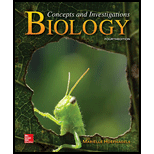
Which of the following best describes aerobic respiration?
a. The production of ATP from glucose in the presence of oxygen
b. The production of pyruvate in the absence of oxygen
c. The production of pyruvate using energy from the sun
d. The production of ATP from glucose in the absence of oxygen
Introduction:
The process in which energy required for cellular functions is released in the presence of oxygen is called as aerobic respiration. It is a multistep process in which the body cells break down food in mitochondria to release energy. ATP is the form of energy released by cellular respiration.
Answer to Problem 1MCQ
Correct answer:
Aerobic respiration requires oxygen and carbohydrates to produce ATP, which is the energy form required for various cellular processes. Therefore option a. is the correct answer.
Explanation of Solution
Reason for the correct statement:
In aerobic respiration, the first step is the breakdown of glucose molecules into carbon dioxide and water to release ATP. This process is known as glycolysis.
Option a. is given as “the production of ATP from glucose in the presence of oxygen”.
As, “the production of ATP from glucose in the presence of oxygen best describes the aerobic respiration”, is the right answer.
Hence option a. is correct.
Reasons for the incorrect statements:
Option b. is given as “the production of pyruvate in the absence of oxygen”.
The production of pyruvate in the absence of oxygen is a process of anaerobic respiration. So, it is a wrong answer.
Option c. is given as “the production of pyruvate using energy from the sun”.
The production of pyruvate takes place from the process of glycolysis and not from the energy of sun. So, it is a wrong answer.
Option d. is given as “the production of ATP from glucose in the absence of oxygen”.
Aerobic respiration requires the presence of oxygen. So, it is a wrong answer.
Hence, options b., c., and d. are incorrect.
Aerobic cellular respiration involves the breakdown of glucose molecules in the presence of oxygen to release water, carbon dioxide and ATP.
Want to see more full solutions like this?
Chapter 6 Solutions
Biology: Concepts and Investigations
Additional Science Textbook Solutions
Biological Science (6th Edition)
College Physics: A Strategic Approach (3rd Edition)
Organic Chemistry (8th Edition)
Biology: Concepts and Investigations
Laboratory Manual For Human Anatomy & Physiology
- In a small summary write down:arrow_forwardNot part of a graded assignment, from a past midtermarrow_forwardNoggin mutation: The mouse, one of the phenotypic consequences of Noggin mutationis mispatterning of the spinal cord, in the posterior region of the mouse embryo, suchthat in the hindlimb region the more ventral fates are lost, and the dorsal Pax3 domain isexpanded. (this experiment is not in the lectures).a. Hypothesis for why: What would be your hypothesis for why the ventral fatesare lost and dorsal fates expanded? Include in your answer the words notochord,BMP, SHH and either (or both of) surface ectoderm or lateral plate mesodermarrow_forward

 Human Biology (MindTap Course List)BiologyISBN:9781305112100Author:Cecie Starr, Beverly McMillanPublisher:Cengage Learning
Human Biology (MindTap Course List)BiologyISBN:9781305112100Author:Cecie Starr, Beverly McMillanPublisher:Cengage Learning Biology (MindTap Course List)BiologyISBN:9781337392938Author:Eldra Solomon, Charles Martin, Diana W. Martin, Linda R. BergPublisher:Cengage Learning
Biology (MindTap Course List)BiologyISBN:9781337392938Author:Eldra Solomon, Charles Martin, Diana W. Martin, Linda R. BergPublisher:Cengage Learning Concepts of BiologyBiologyISBN:9781938168116Author:Samantha Fowler, Rebecca Roush, James WisePublisher:OpenStax College
Concepts of BiologyBiologyISBN:9781938168116Author:Samantha Fowler, Rebecca Roush, James WisePublisher:OpenStax College Biology: The Unity and Diversity of Life (MindTap...BiologyISBN:9781305073951Author:Cecie Starr, Ralph Taggart, Christine Evers, Lisa StarrPublisher:Cengage Learning
Biology: The Unity and Diversity of Life (MindTap...BiologyISBN:9781305073951Author:Cecie Starr, Ralph Taggart, Christine Evers, Lisa StarrPublisher:Cengage Learning Human Physiology: From Cells to Systems (MindTap ...BiologyISBN:9781285866932Author:Lauralee SherwoodPublisher:Cengage Learning
Human Physiology: From Cells to Systems (MindTap ...BiologyISBN:9781285866932Author:Lauralee SherwoodPublisher:Cengage Learning





